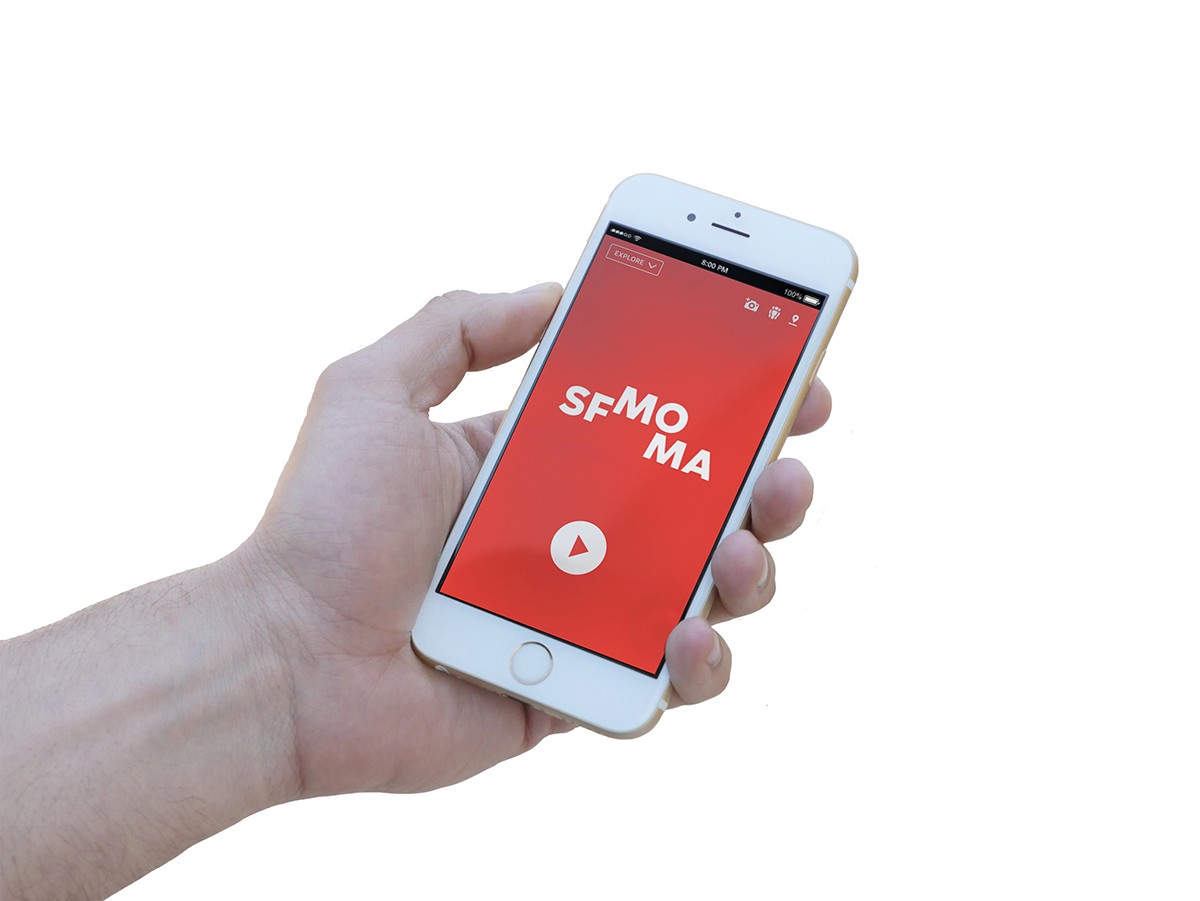At first, the new SFMOMA audio-tour app may take you by surprise. It introduces itself like a new friend with a rather charming voice, and explains that this audio tour experience will be unlike any other you may have had in the past. It knows precisely where you are at all times and tailors the tour to your location. “Oh, that sounds creepy,” says an upbeat woman’s voice. “But it’s not!” Very quickly, you’ll likely warm up to it. It feels a lot like being in the movie Her, except instead of Scarlett Johansson, the people in your ear are artists, curators, actors, dancers, comedians, professional podcasters, and other intriguing figures. They walk through the museum with you in an impressively immersive experience that blends podcast-inspired sound design, geolocation technology, and topnotch storytelling. As the app, which was made available for free download last week, puts it, “I am the love child of people who know art and people who know tech.”
You’re likely aware that, when SFMOMA reopened on May 14 after three years of renovation, it assumed the title of Largest Contemporary Art Museum in America. (For now, until the New York MoMA expansion opens). It boasts seven floors of art and a massively expanded collection of works.
But you may be unaware that, as far as audio tours go, SFMOMA’s new app is kind of a game changer.
As users roam the museum, short explanations for nearby artworks pop onto the screen. To create them, SFMOMA lead mobile content producer Stephanie Pau did an audit of all of the museum’s existing audio-tour content and trashed everything that was boring. Then, she and her team interviewed hundreds of people who might have a unique take on a piece of work — everyone from an accomplished dancer who relates to the gracefulness of an Isamu Noguchi sculpture to the actual subject of a famous portrait.
But the more noteworthy features are the “immersive tours,” which range from fifteen to forty-five minutes. These podcast-like journeys guide visitors through the galleries, delivering a specialized perspective and infusing a rich dimension of personality that traditional art-historical guides typically lack.
Some of these guided strolls are definitely more worthwhile than others, though. “German to Me” takes place on the sixth floor, with the paintings of German painters such as Sigmar Polke and Gerhard Richter. German-American radio producer Luisa Beck expertly weaves her personal narrative together with German history, artist information, and astute descriptions of the pieces to create an affecting exploration of post-war German identity.
Other highlights are “Strange Tools,” a tour in which philosopher Alva Noë uses artworks to illustrate a short lesson on the way that art can challenge the extent to which perception becomes automatic. The charming Avery Trufelman of 99% Invisible offers some enjoyable contributions as well, including a tour that takes place in the neighborhood surrounding the museum.
Some of the tours are obviously made for people who might feel alienated in an art space, and whether you enjoy them will largely depend on your sense of humor. One of the best is “I Don’t Get It,” which features comedians Kumail Janjiani and Martin Starr from the show Silicon Valley and, fittingly, starts off at Marcel Duchamp’s urinal sculpture. The only tour that’s actually difficult to listen to is the one meant to sound like commentating at a sports game — obnoxious horns and all.
But the goal was to offer something for everyone. “We are always thinking about the context of the Bay Area, of the city, of the diversity of the people coming into the museum and what they’re bringing with them,” Pau said, “and how we can respond to that in a way that makes the art relevant to them not just always driving home this art-historical slant.”
Location-informed museum audio tours are not an entirely new concept. But the difference with this one is that, thanks to a special spatial survey of the museum done by Apple, the location recognition is super precise. The app knows exactly how far away from a painting the user is standing. So, directions such as “See that painting to your left?” and “Meet me in front of the Rothko” make the tour feel seamless and allow users to keep their phones in their pockets the entire time.
Being at the center of San Francisco, it makes sense for SFMOMA to come up with such a tech-savvy experience. And visitors hoping to resist the pervasiveness of that tech culture will likely want to avoid the app altogether.
To produce the content, SFMOMA teamed up with Antenna International, one of the largest and best audio-tour companies in the world. Detour, a San Francisco startup that makes similarly immersive outdoor tours of the Bay Area, also helped to produce much of the content as well as design the platform. Detour’s work is generally well-executed, but some of their tours — like one of the Tenderloin neighborhood and one of West Oakland — verge on urban tourism, arguably turning residents into zoo attractions.
In the museum, though, the tours’ collective effect is mostly one of democratizing the authority to speak about art and whose perspective matters. And at an institution like SFMOMA, deposing the role of the art historian is no small coup.
“A lot of the old-school way of doing things is, ‘There is one way to read this work of art; there is one valid institutional way to view this piece,’ and we wanted to just completely break that open,” Pau said. “Seeing that art is a reflection of and part of this wider sphere of what’s happening around us in the world.”
Correction: The original version of this article neglected to report that Detour not only helped to design the platform for the audio tour, but also produced content.














